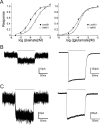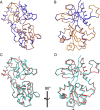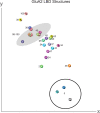Enhanced efficacy without further cleft closure: reevaluating twist as a source of agonist efficacy in AMPA receptors
- PMID: 20107073
- PMCID: PMC2844711
- DOI: 10.1523/JNEUROSCI.4558-09.2010
Enhanced efficacy without further cleft closure: reevaluating twist as a source of agonist efficacy in AMPA receptors
Abstract
AMPA receptors (AMPARs) are tetrameric ligand-gated ion channels that couple the energy of glutamate binding to the opening of a transmembrane channel. Crystallographic and electrophysiological analysis of AMPARs has suggested a coupling between (1) cleft closure in the bilobate ligand-binding domain (LBD), (2) the resulting separation of transmembrane helix attachment points across subunit dimers, and (3) agonist efficacy. In general, more efficacious agonists induce greater degrees of cleft closure and transmembrane separation than partial agonists. Several apparent violations of the cleft-closure/efficacy paradigm have emerged, although in all cases, intradimer separation remains as the driving force for channel opening. Here, we examine the structural basis of partial agonism in GluA4 AMPARs. We find that the L651V substitution enhances the relative efficacy of kainate without increasing either LBD cleft closure or transmembrane separation. Instead, the conformational change relative to the wild-type:kainate complex involves a twisting motion with the efficacy contribution opposite from that expected based on previous analyses. As a result, channel opening may involve transmembrane rearrangements with a significant rotational component. Furthermore, a two-dimensional analysis of agonist-induced GluA2 LBD motions suggests that efficacy is not a linearly varying function of lobe 2 displacement vectors, but is rather determined by specific conformational requirements of the transmembrane domains.
Figures






References
-
- Armstrong N, Gouaux E. Mechanisms for activation and antagonism of an AMPA-sensitive glutamate receptor: crystal structures of the GluR2 ligand binding core. Neuron. 2000;28:165–181. - PubMed
-
- Bjerrum EJ, Biggin PC. Rigid body essential X-ray crystallography: distinguishing the bend and twist of glutamate receptor ligand binding domains. Proteins. 2008;72:434–446. - PubMed
-
- Bocquet N, Nury H, Baaden M, Le Poupon C, Changeux JP, Delarue M, Corringer PJ. X-ray structure of a pentameric ligand-gated ion channel in an apparently open conformation. Nature. 2009;457:111–114. - PubMed
Publication types
MeSH terms
Substances
Grants and funding
LinkOut - more resources
Full Text Sources
Molecular Biology Databases
Research Materials
